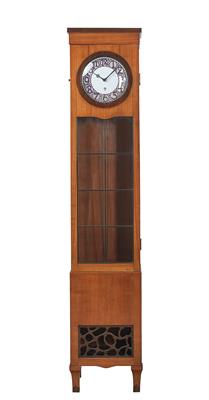A large longcase clock with dial by Adelbert Niemeyer, executed by Porcelain Manufactory Nymphenburg, 1906; casing probably executed by Werkstätte für Wohnungseinrichtung Karl Bertsch, Munich; Kunstausstellung Dresden, 1906
A large longcase clock with dial by Adelbert Niemeyer, executed by Porcelain Manufactory Nymphenburg, 1906; casing probably executed by Werkstätte für Wohnungseinrichtung Karl Bertsch, Munich; Kunstausstellung Dresden, 1906

walnut frame with diverse fruitwoods, the underside with carved, openwork floral motifs; glazed moulded casing, with one lateral door in the upper section; four conical feet; round porcelain dial, dark-red glazed and decorated in gold; with artist’s signet and year no. 06; hands made of black patinated metal; movement by Junghans (c. 1920, not original), pendule clock with 1/2 hour striking mechanism, length of movement: 1 week, two weights, one key, work no.: 94657; signs of age and use, professionally restored; movement not tested; height 199.5 cm. (MP)
Literature:
Alfred Ziffer, Nymphenburger Moderne, Die Porzellan-Manufaktur im 20. Jahrhundert, Münchener Stadtmuseum, Munich 1997, p. 116 (see ill. of the dining room at the 1906 Dresden exhibition).
Adelbert Niemeyer was one of the co-founders of the association of visual artists “Secession” in Munich in 1892. During that time, Niemeyer also travelled to the Ottoman Empire, becoming acquainted with the Iznik ceramics and their floral-abstract repeat decorations. His decorative patterns, especially his “cube decor”, were very well received by the public. Thus wrote Günther von Pechmann about Niemeyer’s work in 1911: “It is a curious fact that Niemeyer, who emphasizes the individual value of artistic work, has created a number of forms here that are so good that no-one asks about their author anymore. (DK, XIV, March 1911, p. 267). This proved that the avant-garde was very interested in Niemeyer services. In 1905, the Wiener Werkstätte requested that references be made, at the same time enquiring whether Nymphenburg Porcelain Manufactory might also be willing to execute designs by Prof. Koloman Moser and Prof. Josef Hoffmann. However, no cooperation agreement was reached.
Also typical of Niemeyer’s style was the combination of strictly geometric forms with floral-abstract ornaments, as demonstrated by the furniture at the Dresden exhibition in 1906. In Alfred Ziffer’s words: “The austerity of geometrically veneered rectangular fields was loosened up carvings in the buffet and table frame, the struts of the glazed display case and the base of a longcase clock, which was part of the ensemble. Its dial was made of Nymphenburg porcelain and painted with a purple-gold numerical border; Niemeyer’s monogram and the date ‘06’ featured under the hand hole.” (Alfred Ziffer, Nymphenburger Moderne, p. 117).
The present longcase clock is probably a unique piece. It is possible that the porcelain dial was created as a prototype for the Dresden exhibition in 1906
Expert: Dr. Magda Pfabigan, M.A.
 Dr. Magda Pfabigan, M.A.
Dr. Magda Pfabigan, M.A.
+43-1-515 60-383
magda.pfabigan@dorotheum.at
09.07.2020 - 16:00
- Odhadní cena:
-
EUR 8.000,- do EUR 12.000,-
A large longcase clock with dial by Adelbert Niemeyer, executed by Porcelain Manufactory Nymphenburg, 1906; casing probably executed by Werkstätte für Wohnungseinrichtung Karl Bertsch, Munich; Kunstausstellung Dresden, 1906
walnut frame with diverse fruitwoods, the underside with carved, openwork floral motifs; glazed moulded casing, with one lateral door in the upper section; four conical feet; round porcelain dial, dark-red glazed and decorated in gold; with artist’s signet and year no. 06; hands made of black patinated metal; movement by Junghans (c. 1920, not original), pendule clock with 1/2 hour striking mechanism, length of movement: 1 week, two weights, one key, work no.: 94657; signs of age and use, professionally restored; movement not tested; height 199.5 cm. (MP)
Literature:
Alfred Ziffer, Nymphenburger Moderne, Die Porzellan-Manufaktur im 20. Jahrhundert, Münchener Stadtmuseum, Munich 1997, p. 116 (see ill. of the dining room at the 1906 Dresden exhibition).
Adelbert Niemeyer was one of the co-founders of the association of visual artists “Secession” in Munich in 1892. During that time, Niemeyer also travelled to the Ottoman Empire, becoming acquainted with the Iznik ceramics and their floral-abstract repeat decorations. His decorative patterns, especially his “cube decor”, were very well received by the public. Thus wrote Günther von Pechmann about Niemeyer’s work in 1911: “It is a curious fact that Niemeyer, who emphasizes the individual value of artistic work, has created a number of forms here that are so good that no-one asks about their author anymore. (DK, XIV, March 1911, p. 267). This proved that the avant-garde was very interested in Niemeyer services. In 1905, the Wiener Werkstätte requested that references be made, at the same time enquiring whether Nymphenburg Porcelain Manufactory might also be willing to execute designs by Prof. Koloman Moser and Prof. Josef Hoffmann. However, no cooperation agreement was reached.
Also typical of Niemeyer’s style was the combination of strictly geometric forms with floral-abstract ornaments, as demonstrated by the furniture at the Dresden exhibition in 1906. In Alfred Ziffer’s words: “The austerity of geometrically veneered rectangular fields was loosened up carvings in the buffet and table frame, the struts of the glazed display case and the base of a longcase clock, which was part of the ensemble. Its dial was made of Nymphenburg porcelain and painted with a purple-gold numerical border; Niemeyer’s monogram and the date ‘06’ featured under the hand hole.” (Alfred Ziffer, Nymphenburger Moderne, p. 117).
The present longcase clock is probably a unique piece. It is possible that the porcelain dial was created as a prototype for the Dresden exhibition in 1906
Expert: Dr. Magda Pfabigan, M.A.
 Dr. Magda Pfabigan, M.A.
Dr. Magda Pfabigan, M.A.
+43-1-515 60-383
magda.pfabigan@dorotheum.at
|
Horká linka kupujících
Po-Pá: 10.00 - 17.00
kundendienst@dorotheum.at +43 1 515 60 200 |
| Aukce: | Secese a umění 20. století |
| Typ aukce: | Salónní aukce |
| Datum: | 09.07.2020 - 16:00 |
| Místo konání aukce: | Wien | Palais Dorotheum |
| Prohlídka: | 03.07. - 09.07.2020 |
